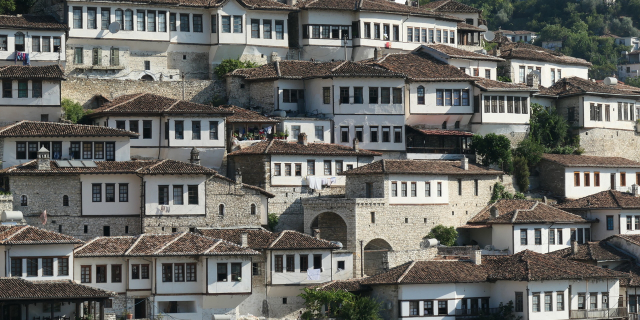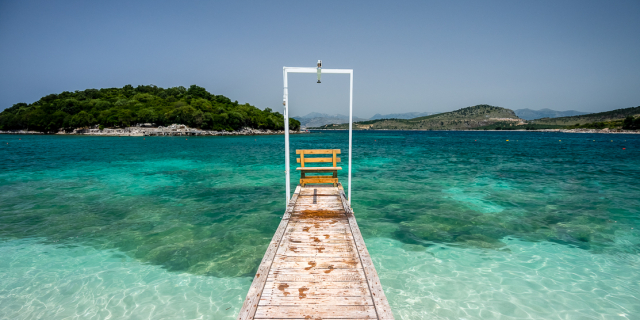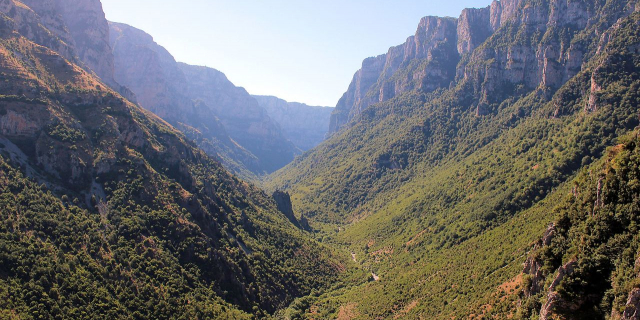Gjirokastër (Albanian: [ɟiɾoˈkast:əɾ, -ra], Albanian definite form: Gjirokastra) is a city in southern Albania and the seat of Gjirokastër County and Gjirokastër Municipality. It is located in a valley between the Gjerë mountains and the Drino, at 300 metres above sea level. Its old town is a UNESCO World Heritage Site, described as "a rare example of a well-preserved Ottoman town, built by farmers of large estate". The city is overlooked by Gjirokastër Fortress, where the Gjirokastër National Folklore Festival is held every five years. It is the birthplace of former Albanian communist leader Enver Hoxha, and author Ismail Kadare.
The city appears in the historical record dating back in 1336 by its medieval Greek name, Αργυρόκαστρο, Read more
Gjirokastër (Albanian: [ɟiɾoˈkast:əɾ, -ra], Albanian definite form: Gjirokastra) is a city in southern Albania and the seat of Gjirokastër County and Gjirokastër Municipality. It is located in a valley between the Gjerë mountains and the Drino, at 300 metres above sea level. Its old town is a UNESCO World Heritage Site, described as "a rare example of a well-preserved Ottoman town, built by farmers of large estate". The city is overlooked by Gjirokastër Fortress, where the Gjirokastër National Folklore Festival is held every five years. It is the birthplace of former Albanian communist leader Enver Hoxha, and author Ismail Kadare.
The city appears in the historical record dating back in 1336 by its medieval Greek name, Αργυρόκαστρο, Argyrókastro, as part of the Byzantine Empire. It first developed in the hill where the Gjirokastër Fortress is located. In this period, Gjirokastër was contested between the Despotate of Epirus and the Albanian clan of Zenebishi under Gjon Zenebishi who made it his capital in 1417. It was taken by the Ottomans in 1418, a year after's Gjon's death and it became the seat of the Sanjak of Albania. Throughout the Ottoman era, Gjirokastër was officially known in Ottoman Turkish as Ergiri and also Ergiri Kasrı. During the Ottoman period conversions to Islam and an influx of Muslim converts from the surrounding countryside made Gjirokastër go from being an overwhelmingly Christian city in the 16th century into one with a large Muslim population by the early 19th century. Gjirokastër also became a major religious centre for Bektashi Sufism.
Taken by the Hellenic Army during the Balkan Wars of 1912–13 Gjirokaster was eventually incorporated into the newly independent state of Albania in 1913. This proved highly unpopular with the local Greek population, who rebelled; after several months of guerrilla warfare, the short-lived Autonomous Republic of Northern Epirus was established in 1914 with Gjirokastër as its capital. It was definitively awarded to Albania in 1921. In more recent years, the city witnessed anti-government protests that led to the Albanian civil war of 1997.
Along with Muslim and Orthodox Albanians, the city is also home to a substantial Greek minority along with a considerable Aromanian community. Together with Sarandë, the city is considered one of the centers of the Greek minority in Albania, and there is a consulate of Greece.
The Phrygian period of the region spanned from around 1150 BCE to around 850 BCE. Hammond argues that the region was checkered with a mosaic of small Phrygian principalities, with the principality of Gjirokastër and the surrounding region having its center at Vodhinë. In the later part of the period, it appears there was a change of dynasty at Vodhine.[1]
Archaeological evidence demonstrates that during the Bronze Age, the region was inhabited by populations who likely spoke a northwestern Greek dialect.[2][improper synthesis?][dubious ] Archaeologists have found pottery artifacts dating to the early Iron Age, crafted in a style that first appeared in the late Bronze Age in Pazhok, Elbasan County, and is found throughout Albania.[3] The earliest recorded inhabitants of the area around Gjirokastër were the ancient Greek tribe of the Chaonians, which belonged to the Epirote group. In antiquity the local urban centre was located in Antigonia, c. 5 kilometres (3 mi) from modern Gjirokastër on the opposite bank of river Drino.[4][5]
Medieval period The Ottoman architecture characterize the historical city center.
The Ottoman architecture characterize the historical city center.Gjirokastër first developed on the hill where the castle of the city is located in the Middle Ages. The first fortification dates to the 5th-6th centuries CE during the period of Slavic migrations to the Balkans. It was expanded in the 9th-10th centuries, while the first signs of actual settlement medieval urban development in the castle area date to the 13th-14th centuries.[6][7] During this period, Gjirokastër developed into a center known in medieval sources as Argyropolis (Medieval Greek: Ἀργυρόπολις, meaning "Silver City") or Argyrokastron (Medieval Greek: Ἀργυρόκαστρον, meaning "Silver Castle").[8] The city was part of the Despotate of Epirus and was first mentioned by the name Argyrokastro by John VI Kantakouzenos in 1336.[9] That year Argyrokastro was among the cities that remained loyal to the Byzantine Emperor during a local Epirote rebellion in favour to Nikephoros II Orsini.[10]
The Zenebishi clan, which held Gjirokastër by the end of the century, is first mentioned in 1304 as land holders in the Angevin holdings in Albania, possibly in the southern coastal area. Laonikos Chalkokondyles mentions that in the era before 1336, Albanian clans from the area of Durrës marched southwards and took control of most areas in Gjirokastër.[11] In this era, the city was contested between the Italian and Serbian rulers which claimed the Despotate of Epirus with occasional Ottoman support and the Zenebishi clan under Gjon Zenebishi. In 1399, the Italian ruler of Ioannina, Esau de' Buondelmonti who was allied to the Ottomans, gathered an army made up of troops from Ioannina, Zagori, Dryinoupolis and Gjirokastër and the Mazaraki and Malakasi clans and marched against Gjon Zenebishi. He was ambushed, defeated and captured along with other lords from Ioannina by Zenebishi near Dhivër.[12] The victory secured the city of Gjirokastër for Gjon Zenebishi and it became his capital.[13] In 1417 Gjon Zenebishi died and was succeeded by his son Simon as lord of Gjirokastër in early 1418. Immediately, the Ottomans besieged the city. Simon left the city during the siege to seek refuge in Ioannina and returned back when the Ottoman siege failed, but nevertheless he eventually surrendered Gjirokastër to the Ottomans. With the acquisition of Gjirokastër, the area became known as Zenebish-ili (land of Zenebishi) and by 1419 became the seat of the Sanjak of Albania.[14]
During the Albanian Revolt of 1432–36 it was besieged by forces under Depë Zenebishi, but the rebels were defeated by Ottoman troops led by Turahan Bey.[15] In 1570s local nobles Manthos Papagiannis and Panos Kestolikos, discussed as Greek representative of enslaved Greece and Albania with the head of the Holy League, John of Austria and various other European rulers, the possibility of an anti-Ottoman armed struggle, but this initiative was fruitless.[16][17][18]
226
Ottoman period (up to 1800)According to Ottoman traveller Evliya Çelebi, who visited the city in 1670, at that time there were 200 houses within the castle, 200 in the Christian eastern neighborhood of Kyçyk Varosh (meaning small neighborhood outside the castle), 150 houses in the Byjyk Varosh (meaning big neighborhood outside the castle), and six additional neighborhoods: Palorto, Vutosh, Dunavat, Manalat, Haxhi Bey, and Memi Bey, extending on eight hills around the castle.[19] According to the traveller, the city had at that time around 2000 houses, eight mosques, three churches, 280 shops, five fountains, and five inns.[19] From the 16th century until the early 19th century Gjirokastër went from being a predominantly Christian city to one with a Muslim majority due to much of the urban population converting to Islam alongside an influx of Muslim converts from the surrounding countryside.[20][21]
Modern View of the fortress and aqueduct of Gjirokastër depicted by Edward Lear, 4 November 1848[22]
View of the fortress and aqueduct of Gjirokastër depicted by Edward Lear, 4 November 1848[22]In 1811, Gjirokastër became part of the Pashalik of Yanina, then led by the Albanian-born Ali Pasha of Ioannina and was transformed into a semi-autonomous fiefdom in the southwestern Balkans until his death in 1822. In 1833 Albanian rebels took over the town causing the Ottoman government to comply with rebel terms.[23] After the fall of the pashalik in 1868, the city was the capital of the sanjak of Ergiri. On 23 July 1880, southern Albanian committees of the League of Prizren held a congress in the city, in which was decided that if Albanian-populated areas of the Ottoman Empire were ceded to neighbouring countries, they would revolt.[24] During the Albanian National Awakening (1831–1912), the city was a major centre of the movement, and some groups in the city were reported to carry portraits of Skanderbeg, the national hero of the Albanians during this period.[25] Gjirokastër from the middle of the nineteenth century also prominently contributed to the wider Ottoman Empire through individuals that served as Kadıs (civil servants) and was an important centre of Islamic culture.[26] In early March 1908, the binbashi of Gjirokastër was assassinated by Çerçiz Topulli and his followers.[27] The pro-Albanianists of the city during 1909–1912 were split between two groups: the urban liberals who wanted to cooperate with the Greeks and Albanian nationalists who formed guerilla bands operating in the countryside.[21] During the 19th and early 20th century, Albanian speaking Muslims were the majority population of Gjirokastër, while a small number of Greek-speaking families lived there.[21]
 The official declaration of the Autonomous Republic of Northern Epirus March 1, 1914. The River Drino seen in the background.
The official declaration of the Autonomous Republic of Northern Epirus March 1, 1914. The River Drino seen in the background.Given its Greek minority, the city was claimed and taken by Greece during the First Balkan War of 1912–1913, following the retreat of the Ottomans from the region.[28] However, it was awarded to Albania under the terms of the Treaty of London of 1913 and the Protocol of Florence of 17 December 1913.[29]
This turn of events proved highly unpopular with the local Greek population, and their representatives under Georgios Christakis-Zografos formed the Panepirotic Assembly in Gjirokastër in protest.[30] The Assembly, short of incorporation with Greece, demanded either local autonomy or an international occupation by forces of the Great Powers for the districts of Gjirokastër, Sarandë, and Korçë.[31]
In April 1939, Gjirokastër was occupied by Italy following the Italian invasion of Albania. On December 8, 1940, during the Greco-Italian War, the Hellenic Army entered the city and stayed for a five-month period before capitulating to Nazi Germany in April 1941 and returning the city to Italian command. After the capitulation of Italy in the Armistice of Cassibile in September 1943, the city was taken by German forces and eventually returned to Albanian control in 1944.
 House of the post-war leader Enver Hoxha, where he grew up
House of the post-war leader Enver Hoxha, where he grew up Konak (house) of writer Ismail Kadare in Gjirokastër
Konak (house) of writer Ismail Kadare in GjirokastërThe postwar communist regime developed the city as an industrial and commercial centre. It was elevated to the status of a museum town,[32] as it was the birthplace of the leader of the People's Socialist Republic of Albania, Enver Hoxha, who had been born there in 1908. His house was converted into a museum.[33]
The demolition of the monumental statue of the authoritarian leader Enver Hoxha in Gjirokastër by members of the local Greek community in August 1991 marked the end of the one-party state[34] It was the last statue in Albania to be demolished during the Fall of Communism in Albania, which happened in 28 July 1991, 5 months after the rest of the statues that were demolished since February and marked the end of the one-party state.[35]
Gjirokastër suffered severe economic problems following the end of communist rule in 1991. In the spring of 1993, the region of Gjirokastër became a center of open conflict between Greek minority members and the Albanian police.[36] The city was particularly affected by the 1997 collapse of a massive pyramid scheme which destabilised the entire Albanian economy.[37] The city became the focus of a rebellion against the government of Sali Berisha; violent anti-government protests took place which eventually forced Berisha's resignation. On 16 December 1997, Hoxha's house was damaged by unknown attackers, but subsequently restored.[38]

































Add new comment